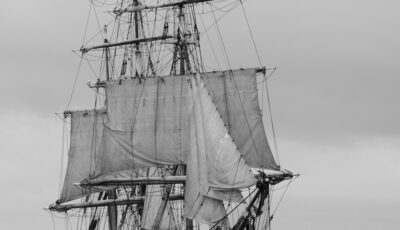The Jeanie Johnston is a ship steeped in history, a poignant symbol of Ireland’s Great Famine. Built in 1847 in Quebec, Canada, this ship was designed to transport goods between Ireland and North America. However, it became famous for an entirely different reason: the transport of Irish emigrants fleeing the Great Famine to North America. Her tragic sinking in 1858 caused a stir among the Irish population, although no deaths were reported.

The Jeanie Johnston – wrobell – cc
Originally built as a merchant ship, the original Jeanie Johnston played a crucial role in transporting goods between Ireland and North America. However, her destiny took a historic turn on April 24, 1848, when she embarked on her maiden voyage as an immigrant ship.
At the time, Ireland was in the grip of a great famine, prompting many Irish to seek a better life in North America. Between 1848 and 1855, the Jeanie Johnston made 16 transatlantic crossings, setting course for destinations such as Quebec City, Baltimore and New York.
These trips weren’t just simple journeys. On average, they lasted 47 days, a long ordeal for passengers and crew alike. One of the most remarkable voyages was that of April 17, 1852, from Tralee to Quebec City, where the ship carried 254 passengers, an impressive number compared to the 40-passenger capacity of her modern replica.
Despite the overcrowding and challenges of transatlantic travel, the Jeanie Johnston stands out for one remarkable fact: not a single passenger or crew member lost their life on board, a testament to the ship’s exceptional safety and management.
Despite the difficult conditions of the transatlantic crossing and the high risk of illness and death, no lives were lost on board the Jeanie Johnston during her 16 voyages as an emigrant ship. This success is attributed to the skill of its captain, James Attridge, and the particular attention paid to the health and well-being of passengers.
The Jeanie Johnston finally changed hands in 1855, sold to William Johnson of North Shields, England.
Its final chapter was written in 1858, during a trip to Quebec City.
The sinking of the Jeanie Johnston in 1858 was an event marked by a series of unfortunate circumstances. The shipwreck occurred on one of its regular commercial voyages, after the vessel had stopped carrying immigrants.
The Jeanie Johnston was sailing to Quebec City, loaded with merchandise. The tragedy began with a leak, an alarming occurrence on the high seas. The precise details of the cause of this leak are not clearly documented, but it is common for wooden ships of this era to suffer such damage, often due to structural damage or adverse weather conditions.
Faced with this critical situation, the crew had to take desperate measures. They took refuge in the ship’s rigging, a precarious and dangerous position, especially at sea.
For nine days, they endured extreme conditions, fighting for survival as the Jeanie Johnston slowly took on water and began to sink.
Their salvation came in the form of the Sophie Elizabeth, a Dutch vessel that spotted the Jeanie Johnston in distress. The crew of the Jeanie Johnston were rescued and taken to safety, ending their ordeal at sea.
No fatalities were reported.
This sinking marks the end of the Jeanie Johnston’s history, a ship that, despite its tragic end, remains famous for its exceptional safety record on its immigrant voyages, a legacy that contrasts sharply with its final fate.

The replica of the Jeanie Johnston in Dublin – © Irina
A faithful replica of the Jeanie Johnston was built and launched in 2002, and is now moored in Dublin.
It serves as a floating museum, offering visitors a glimpse of life on board and the history of Irish emigrants.
This fascinating copy of the ship will appeal to lovers of maritime history, as well as the history of Irish emigration. One of the top 10 museums to visit in Dublin!